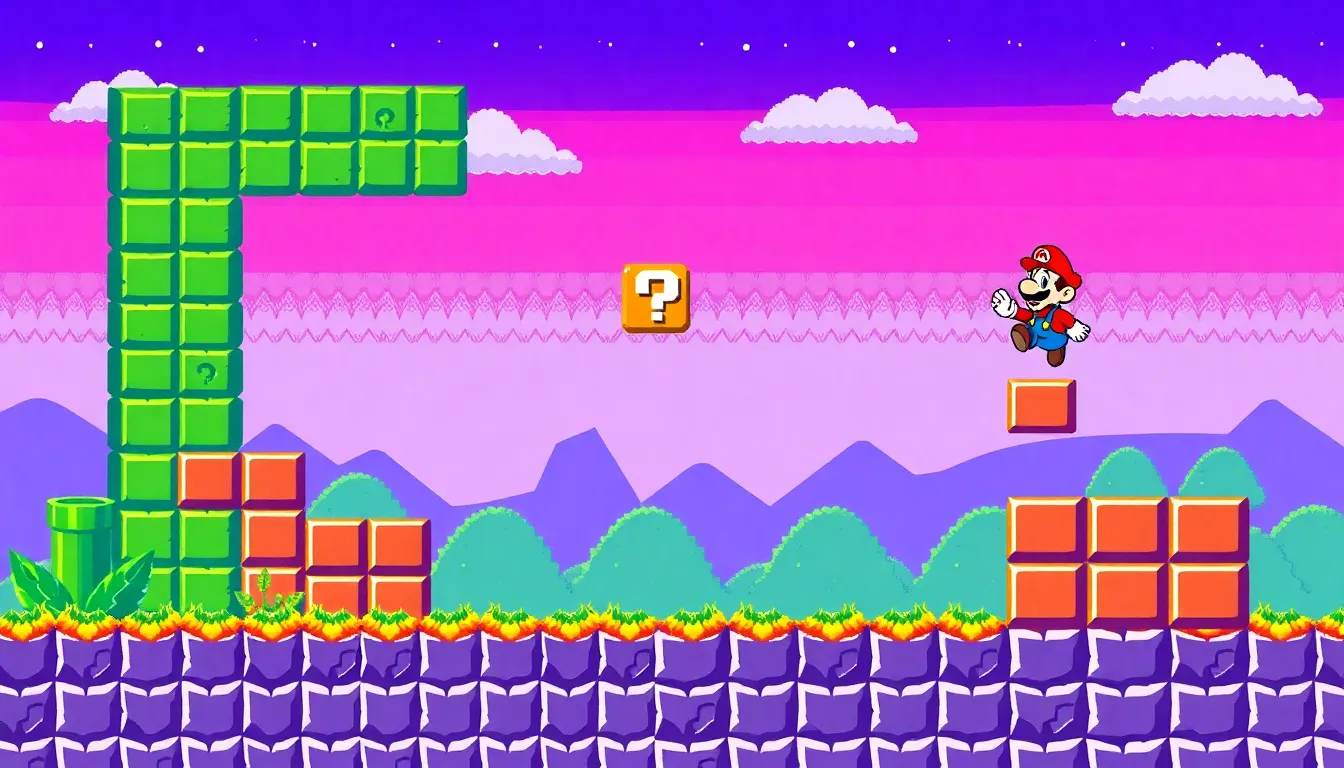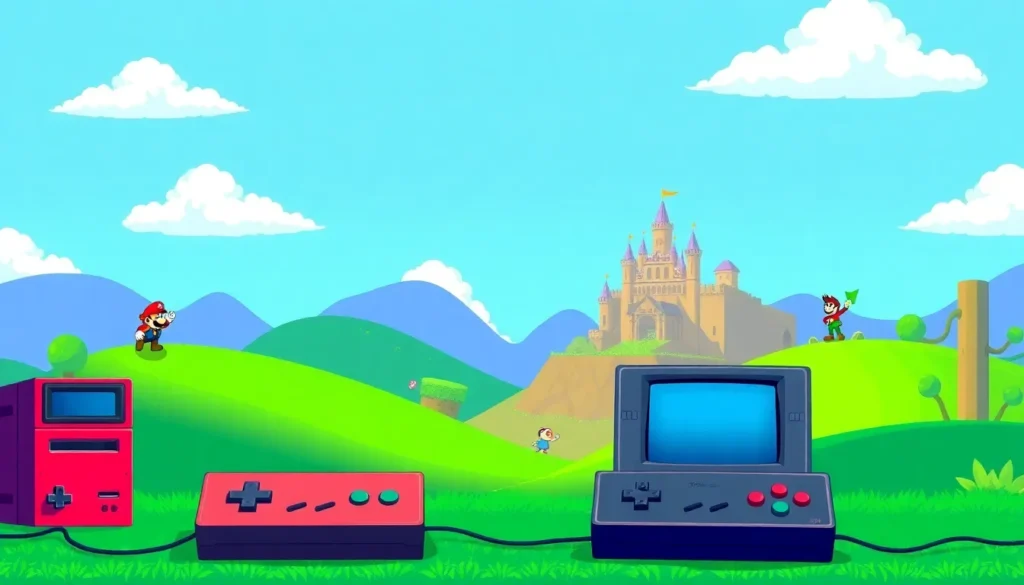In a world dominated by hyper-realistic graphics and immersive storytelling, the charm of 8-bit video games still holds a special place in gamers’ hearts. These pixelated wonders may seem simplistic, but they pack a nostalgia punch that transports players back to a time when gaming was all about creativity and fun. With their catchy soundtracks and quirky characters, 8-bit games are like the retro candy of the gaming universe—sweet, satisfying, and a little bit addictive.
Imagine dodging pixelated enemies while collecting coins that sound like they’re straight out of a chiptune concert. It’s not just about winning; it’s about reliving those epic moments with friends and discovering hidden secrets in every corner. Whether you’re a seasoned gamer or just curious about the past, diving into the world of 8-bit games is like stepping into a time machine—one that’s guaranteed to ignite your imagination and spark a smile.
8 Bit Video Game
8-bit video games originated in the 1970s and significantly influenced the gaming industry. These games combined limited technology with innovative gameplay, establishing a foundation for future developments.
Origins In The 1970s
The 1970s marked the beginning of 8-bit gaming with the introduction of home consoles like the Magnavox Odyssey in 1972. These early systems featured simple graphics and sound, captivating players with their unique experience. Notably, Atari’s breakout success in 1977 gave rise to a burgeoning market, drawing more developers into the space. Games like “Pong” set the stage for arcade gameplay, showcasing the potential of interactive entertainment. Players embraced the accessibility of these early consoles, sparking a trend that would lead to more sophisticated technology in the years to come.
The Golden Age Of Arcade Games
The golden age of arcade games, spanning from the late 1970s to the early 1980s, brought iconic titles to the forefront. During this era, classic games such as “Space Invaders” and “Pac-Man” became household names, leading to widespread popularity. Developers leveraged 8-bit graphics to create engaging experiences that captivated players. Increased competition spurred innovation, with companies racing to produce the next blockbuster game. Coins clicked and challenges soared as gamers gathered in arcades, forming a social atmosphere that inspired many. This period established a strong cultural foundation, laying the groundwork for future home console success.
Iconic 8 Bit Video Games

8-bit video games left a significant mark on gaming history. Iconic titles such as “Super Mario Bros.” and “The Legend of Zelda” continue to influence modern gaming.
Super Mario Bros.
“Super Mario Bros.” revolutionized platform gaming upon its 1985 release. Players navigate through various levels while controlling Mario, aiming to rescue Princess Toadstool from Bowser. The game introduced power-ups, including the Super Mushroom and Fire Flower, enhancing gameplay mechanics. With its tight controls and engaging level design, it set a standard for future platformers. The catchy music, composed by Koji Kondo, remains memorable decades later. Multiplayer options allowed friends to enjoy the adventure together, fostering a sense of camaraderie.
The Legend of Zelda
Released in 1986, “The Legend of Zelda” pioneered action-adventure games. Players assume the role of Link, tasked with rescuing Princess Zelda and defeating Ganon. This game showcased an expansive overworld, encouraging exploration and discovery. Players found secrets, treasures, and various items enhancing gameplay depth. The innovative save feature allowed progress to be retained, a rarity at the time. Unique puzzles combined with combat challenges solidified its status as a groundbreaking title. Its music, also by Koji Kondo, became iconic, enriching the player experience.
The Impact Of 8 Bit Video Games
8-bit video games hold a special place in gaming history. Their influence stretches far beyond pixels and soundtracks, leaving lasting impressions on culture and the gaming industry.
Cultural Significance
Cultural significance is evident in the way 8-bit games shaped childhoods across generations. Characters like Mario and Link became cultural icons, symbolizing the golden age of gaming. Fan conventions often celebrate these classics, showcasing art, music, and merchandise inspired by 8-bit aesthetics. Additionally, retro-themed events attract gamers who appreciate nostalgia while fostering community through shared experiences. Collectors actively preserve vintage consoles and cartridges, emphasizing the importance of these games in preserving gaming heritage.
Influence On Modern Gaming
Influence on modern gaming appears through mechanics and storytelling techniques that originated in 8-bit titles. Platforming elements introduced in games like “Super Mario Bros.” laid foundations for countless franchises today. Open-world exploration influenced by “The Legend of Zelda” creates immersive experiences in contemporary titles. Art styles draw inspiration from pixel art, evidenced in indie games that capture the charm of earlier eras. Music created by composers like Koji Kondo remains integral to game design, affirming the enduring legacy of 8-bit soundtracks in contemporary gaming landscapes.
Tips For Enjoying 8 Bit Video Games Today
Engaging with 8-bit video games today requires a few thoughtful considerations. These tips enhance the nostalgic gaming experience while connecting with modern technology.
Finding Retro Consoles
Locating retro consoles can be an exciting adventure. Check online marketplaces like eBay or specialized retro gaming stores for classic systems. Auctions often feature desirable models, attracting collectors. Local flea markets and pawn shops sometimes hide rare gems. Seek out community forums or social media groups dedicated to retro gaming; members frequently share leads on available consoles. It’s common to find refurbished units that maintain original functionality. Many gamers benefit from attending gaming conventions, showcasing vendors who sell retro equipment.
Downloading Emulators
Utilizing emulators expands access to classic games without original hardware. Various emulator options exist, each with unique features catering to beginners and enthusiasts. Websites like RetroArch offer user-friendly interfaces for easy navigation. Potential users should research compatibility lists to ensure games play smoothly. Downloading ROMs is straightforward but requires caution; confirm legal ownership before acquiring them. Many communities offer support for troubleshooting common issues, enhancing gameplay experiences. Customization options in emulators often allow players to enhance visuals or add filters, providing a personalized touch to the 8-bit experience.
Conclusion
The charm of 8-bit video games continues to resonate with players of all ages. Their pixelated graphics and catchy soundtracks transport gamers back to a simpler time filled with creativity and joy. As iconic titles like “Super Mario Bros.” and “The Legend of Zelda” remain influential, they serve as reminders of the innovation that defined an era.
Engaging with these classics not only fosters nostalgia but also connects players to a vibrant community that celebrates retro gaming. Whether through original consoles or modern emulators, the experience of playing 8-bit games is a delightful journey worth exploring. This legacy of fun and camaraderie ensures that the spirit of 8-bit gaming will endure for generations to come.

